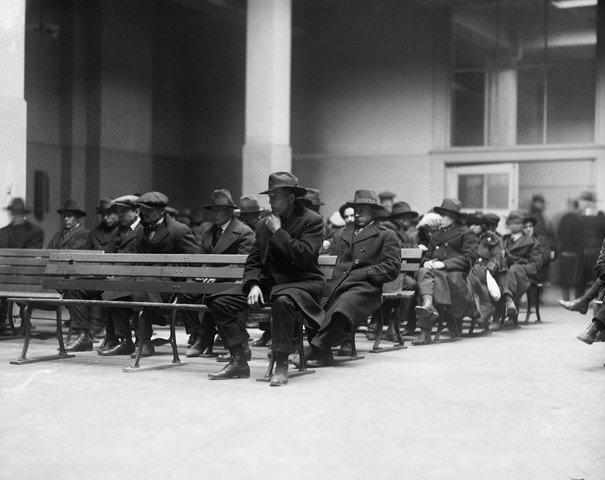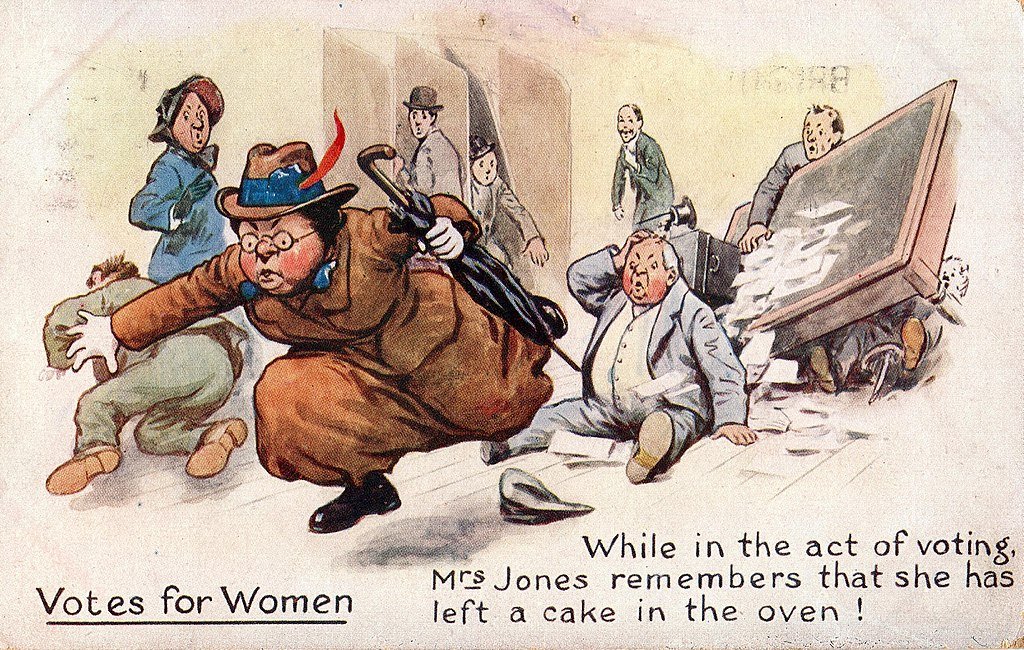The Bolsheviks’ toppling of the Russian government during the Russian Revolution of 1917 led to 30,000 Russians coming to the United States. Then, in the late 1910s, a series of bombings that some called the ‘Red Scare’ ensued. The U.S. Attorney General retaliated with several actions, including what has come to be known as the Palmer Raids.
Janel Miller explains.
Men arrested in during the Palmer Raids are shown here on Ellis Island, New York awaiting deportation hearings in January 1920.
Bombs Sent to Politicians
To start with, in the days leading up to May Day (May 1), 1919, bombs were sent to at least 23 United States addresses. Some of the recipients were politicians. One of these attacks injured the housekeeper of a Georgia lawmaker.
Another round of bomb attacks on United States judges, politicians and law enforcement officials occurred about a month later. One of the attacks occurred on June 2 in front of the home of 1920 presidential hopeful and the U.S. Attorney General during part of Woodrow Wilson’s administration, A. Mitchell Palmer. The nation’s top lawyer immediately called for an investigation to determine who was responsible.
This investigation suggested that individuals often called radicals in the press were responsible. Subsequently, Palmer used that information, along with the 1918 Sedition Act (which limited free speech), to seek and persecute these individuals.
1919 Raids Targeted Radicals
The Kansas City Times reported that on November 7, with the intent of abating a nationwide plan "to defy governmental authority”, the federal government conducted raids and searches in roughly two dozen municipalities.
One of the raids that day took place in New York, where 200 people that federal authorities called radicals were arrested and another 50 alleged radicals were scheduled for deportation. Other raids, most of them with fewer arrests, took place around the same time in Chicago, St. Louis, Detroit, and Philadelphia. At least some of these searches yielded printed materials discussing the nationwide plan, making bombs and/or producing counterfeit documents. In Johnstown, Pennsylvania, no arrests were made, but a group of business leaders banished two people said to be labor organizers from the city. These actions coincided with the second anniversary of the birth of the Bolshevik government that so many Russian immigrants had tried to flee.
Not convinced the threat posed by those he called radicals was over, Palmer called for a law that, among other things, would allow radicals to be arrested even if they acted alone (at the time of Palmer’s request, only radicals working in groups of two or more could be arrested). He also claimed some of the 222 United States newspapers published in foreign languages encouraged violent overthrows of the U.S. government.
Palmer also asked for enhanced Justice Department facilities and the creation of a parole board that would relieve some of the Justice Department’s work burden and he also oversaw the deportation of 249 radicals via the U.S.S. Buford on December 21.
Raids Also Occurred in 1920
On January 2, 1920, another round of raids occurred in large United States municipalities such as Philadelphia and Chicago, as well as smaller ones such as Cortland, New York; Nashua, New Hampshire; Olneyville, Rhode Island; and Lynn and Brockton, Massachusetts. These January raids resulted in 10,000 individuals arrested who federal authorities said were members of the Communist and Communist Labor parties.
The following month, in an essay Palmer authored titled “The Case Against the Reds,” he stated his actions would prevent the “horror and terrorism of bolshevik tyranny” that was underway in Russia from occurring in the United States. Soon after the essay’s publication, Palmer claimed that radical-led attacks would occur on May Day, 1920, just as they had the year before.
Palmer Had His Detractors
Support for Palmer’s actions was not universal. For example, Francis Fisher Kane, the U.S. Attorney for Eastern Pennsylvania, resigned rather than follow Palmer’s directives. Also, an essay published by future United States Supreme Court Justice Felix Frankfurter and Harvard Law School Dean Roscoe Pound discussed what the authors felt were the many legal problems with Palmer’s raids and other actions.
In addition, there were a few immigration inspectors who refused to follow instructions that Palmer authorized or approved. The Lewiston Daily Sun openly sought lawmakers willing to "expose the hollowness of the Palmer holler." The newly formed American Civil Liberties Union claimed Palmer’s actions were based on opinions, not laws.
The Des Moines News stated that the Attorney General was "intimating that the labor department was letting off the reds and failing to deport them.” The newspaper reported that in contrast, members of the Labor Department accused Palmer of "deliberately framing up cases upon perfectly innocent foreigners and endeavoring to make a record by wholesale arrests on the flimsiest kind of evidence and in many cases without proper warrants.”
The attacks of May Day, 1920 that Palmer predicted failed to come to fruition, further damaging his credibility. The one-time 1920 presidential hopeful received 267 nominating votes for president that year, but Republican Warren G. Harding was ultimately elected president and Palmer left office rather than serve with his administration. Although Palmer would remain active in Democratic causes for the rest of his life, his hopes of becoming United States president were never realized.
In Context
Parallels can be drawn between this chapter in United States history and several events that preceded and followed it. For example, four-year-old Dorothy Good faced accusations of being a witch during the hysteria known as the Salem Witch Trials of the 1690s because her mother was accused of witchcraft. In 2015, after the killing of a Californian woman by a man in the United States illegally, then-presidential candidate Donald J. Trump said that Mexico was sending the U.S. people with “lots of problems,” according to the Los Angeles Times.
What do you think of the Palmer Raids? Let us know below.
References
“Russian Beginnings.” https://www.loc.gov/classroom-materials/immigration/polish-russian/russian-beginnings. Library of Congress. Accessed October 22, 2022.
Palmer Raids. https://www.fbi.gov/history/famous-cases/palmer-raids. FBI. Accessed October 11, 2022.
Blumberg, Jess. “A Brief History of the Salem Witch Trials.” https://www.smithsonianmag.com/history/a-brief-history-of-the-salem-witch-trials-175162489/. Published Oct. 23, 2007. Accessed October 24, 2022.
Hennessey, Kathleen. “Trump Takes On Mexican Government In Comments On Immigrants.” https://www.latimes.com/nation/la-na-trump-mexican-immigrants-20150706-story.html. Published July 6, 2015. Accessed Oct. 23, 2022.
“Nation Wide Hunt for May Day Bombs.” https://www.newspapers.com/image/837246919. Holyoke Daily Transcript, page 1. Published May 1, 1919. Accessed October 23, 2022.
Palmer Raids. https://www.fbi.gov/history/famous-cases/palmer-raids. FBI. Accessed October 11, 2022.
Attorney General: Alexander Mitchell Palmer. https://www.justice.gov/ag/bio/palmer-alexander-mitchell. U.S. Department of Justice. Accessed October 11, 2022.
Palmer Raids. https://www.fbi.gov/history/famous-cases/palmer-raids. FBI. Accessed October 11, 2022.
Boyd, Christina L. “Sedition Act of 1918.” https://mtsu.edu/first-amendment/article/1239/sedition-act-of-1918. The First Amendment Encyclopedia. Accessed October 11, 2022.
“’Reds’ In Raid Net.” https://www.newspapers.com/image/654292552. The Kansas City Times, page 1. Published November. 8, 1919, Accessed October 22, 2022.
“Raid Radicals In 18 Cities.” https://www.newspapers.com/image/614412771. The York Dispatch, page 1. Published November 8, 1919. Accessed October 22, 2022.
“Must Have Laws to Curb Radicals Palmer Declares.” https://www.newspapers.com/image/825798158. The Macon Daily Telegraph, page 1. Published November. 16, 1919. Accessed September 28, 2022.
“Palmer’s Report on the Reds and Their Work.” https://www.newspapers.com/image/552827864. The Gazette and Daily, page 8. Published Dec. 9, 1919. Accessed September 28, 2022.
“Second Ark to Leave.” https://newspaperarchive.com/ogden-standard-dec-22-1919p-1/. The Ogden Standard, page 1. Published December 22, 1919. Accessed October 23, 2022.
Williams, David. “The Bureau of Investigation and Its Critics, 1919-1921: The Origins of Federal Political Surveillance.” The Journal of American History. (68): 560-579. Accessed October 15, 2022.
“100 More ‘Reds’ Taken In New England Raids.”. New York Tribune, page 2. Published January 4, 1920. Accessed Oct. 23, 2022.
“130 Raid Prisoners in Philadelphia District to Be Held For Hearing.” https://www.newspapers.com/image/78218686. New York Tribune, page 2. Published January 4, 1920. Accessed October 23, 2022.
“’Perfect Cases’ Against 2,616 Taken In Raids Is Claim of Federal Agents.” https://www.newspapers.com/image/542621138. The Muscatine Journal and News-Tribune, page 1. Published January 3, 1920. Accessed October 23, 2022.
Palmer, Mitchell A. “The Case Against the ‘Reds.’” Forum 63 (1920): 173–185. http://historymatters.gmu.edu/d/4993/. Accessed October 23, 2022.
“Department of Justice Agents Chosen for Assassination.” https://newspaperarchive.com/biloxi-daily-herald-apr-30-1920-p-1/. The Daily Herald, page 1. Published April 30, 1920. Accessed October 23, 2022.
“Kane Quit Because of Palmer’s Raids to Catch Radicals.” https://www.newspapers.com/image/162305073. Evening Public Ledger, page 1. Published January 23, 1920. Accessed September 28, 2022.
NCC Staff. “On This Day, Massive Raids During the Red Scare.” https://constitutioncenter.org/blog/on-this-day-massive-raids-during-the-red-scare. The Constitution Center. Published January 2, 2022. Accessed October. 11, 2022.
Williams, D. “The Bureau of Investigation and Its Critics, 1919-1921: The Origins of Federal Political Surveillance.” The Journal of American History. (68): 560-579. Accessed October 15, 2022.
“Editorial.” https://www.newspapers.com/image/828299251. The Lewiston Daily Sun, page 4. Published January. 24, 1920. Accessed September 28, 2022.
ACLU History. https://www.aclu.org/about/aclu-history. American Civil Liberties Union. Accessed October. 11, 2022.
“Impeachment.”. https://newspaperarchive.com/des-moines-news-apr-23-1920-p-6/. The Des Moines News, page 6. Published April 23, 1920. Accessed October 23, 2022.
“On This Day, Massive Raids During the Red Scare.” https://constitutioncenter.org/blog/on-this-day-massive-raids-during-the-. The Constitution Center. Published January 2, 2022. Accessed October. 11, 2022.
Attorney General: Alexander Mitchell Palmer. https://www.justice.gov/ag/bio/palmer-alexander-mitchell. U.S. Department of Justice. Accessed October 11, 2022.
Warren G. Harding. https://www.whitehouse.gov/about-the-white-house/presidents/warren-g. whitehouse.gov. Accessed October 23, 2022.
“A. Mitchell Palmer.” https://www.mtsu.edu/first-amendment/article/1273/a-mitchell-palmer. The First Amendment Encyclopedia. Accessed October 26, 2022.
















